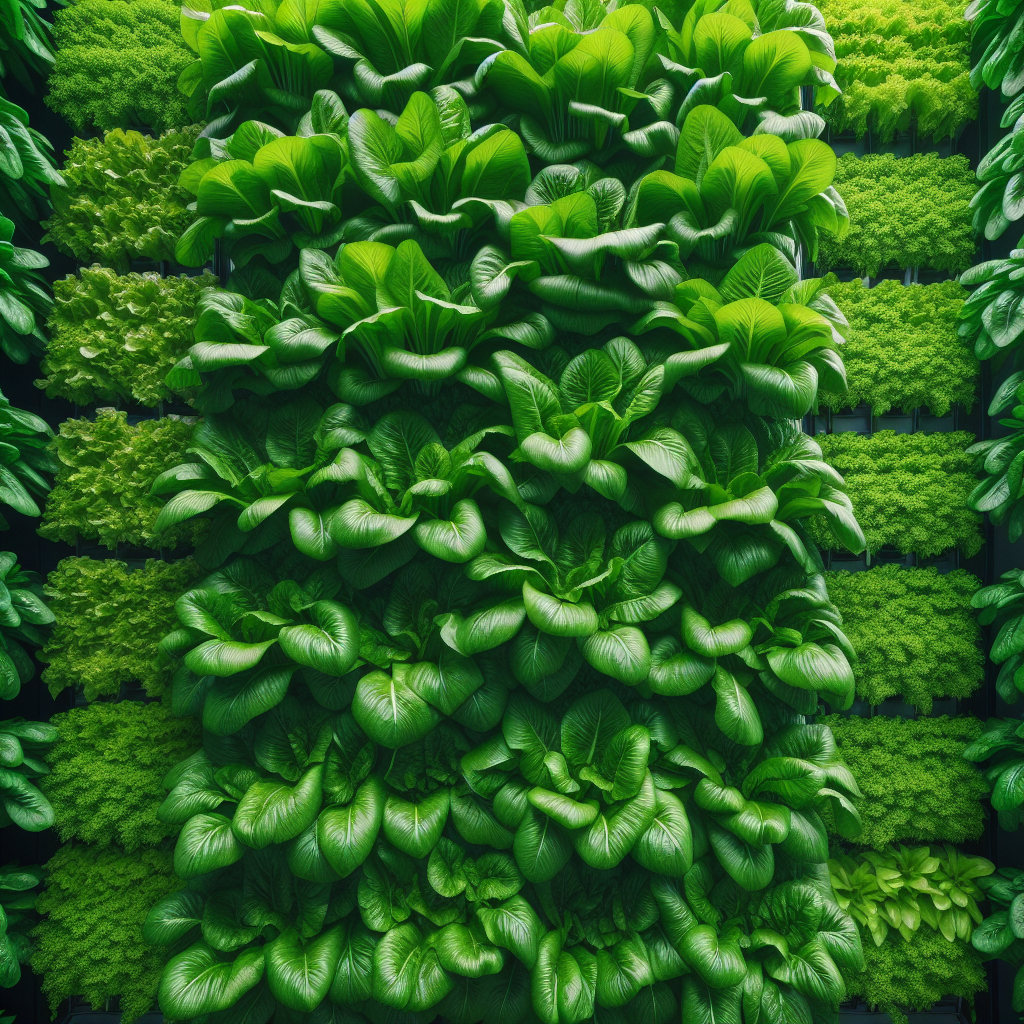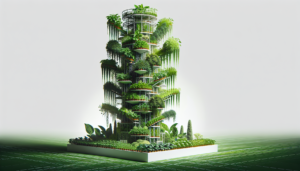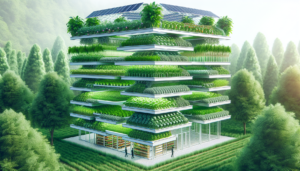
In this captivating article, you will discover the incredible advancements and game-changing impact of vertical farming in Germany. This innovative method of agriculture is revolutionizing the way crops are grown, maximizing space utilization, and reducing water and pesticide usage. With Germany at the forefront of this cutting-edge technology, vertical farming is paving the way for sustainable and efficient food production. Prepare to be amazed by the possibilities and potential of this rising trend in agriculture.
Benefits of Vertical Farming
Increased Crop Yield
Vertical farming allows for maximized crop yield in a limited space. By utilizing vertical stacking systems and efficient growing methods, such as hydroponics and aeroponics, farmers are able to grow multiple layers of crops. This significantly increases the overall yield compared to traditional farming methods, where space is constrained to a single plane.
Water Conservation
Water scarcity is a growing concern in many parts of the world. Vertical farming offers a solution by minimizing water usage through advanced irrigation techniques such as hydroponics. In hydroponics, plants are grown in a soil-less medium with water and nutrients delivered directly to their roots. This method uses up to 90% less water compared to conventional farming, making it an environmentally friendly choice.
Reduced Pesticide Usage
Vertical farming provides a controlled environment that is less susceptible to pests and diseases. With the ability to monitor and regulate factors like temperature, humidity, and lighting, farmers can create optimal growing conditions without the need for excessive pesticide use. This not only reduces the potential harm to human health but also minimizes the impact on the surrounding ecosystem.
Year-Round Production
Traditional agriculture is limited by seasonal changes and weather conditions. However, vertical farming enables year-round production by providing a controlled environment that can mimic ideal growing conditions regardless of the external climate. By utilizing LED lighting and precise climate control systems, crops can be grown continuously, ensuring a consistent and reliable food supply.
Technology and Techniques Used in Vertical Farming
Hydroponics
Hydroponics is a growing technique that eliminates the need for soil and uses nutrient-rich water instead to nourish plants. This method allows for increased control over plant nutrition and growth, as well as more efficient water usage. By delivering water and nutrients directly to the plant’s root system, hydroponics can accelerate growth and improve overall crop yield.
Aeroponics
Aeroponics is a cutting-edge technique that suspends plants in air and sprays their roots with a nutrient-rich mist. This method allows for maximum oxygenation and nutrient absorption, resulting in faster growth and healthier plants. Aeroponics is particularly effective in vertical farming systems, as it allows for the efficient use of space while minimizing water usage.
Stacking Systems
Vertical farming relies on stacking systems to maximize space utilization. These systems involve arranging plant beds in multiple layers, allowing for more plants to be grown in a smaller footprint. Stacking systems can be customized to accommodate different types of plants and growth stages, ensuring efficient use of space and optimal growth conditions.
LED Lighting
In the absence of natural sunlight, vertical farms rely on artificial lighting to provide the necessary light energy for photosynthesis. LED lighting is the preferred choice for vertical farming due to its energy efficiency, long lifespan, and the ability to provide specific light spectra tailored to different plant needs. LED lights can be adjusted to mimic sunlight, promoting healthy plant growth and allowing for year-round production.
Vertical Farming in Germany: A Growing Trend
Government Support and Funding
Germany has recognized the potential of vertical farming in addressing food security and sustainability challenges. The government has taken an active role in supporting vertical farming initiatives through funding programs, grants, and innovation centers. These efforts have helped accelerate the growth of vertical farming in the country and attract entrepreneurs and investors to the industry.
Advancements in Technology
Germany’s strong focus on research and development has led to significant advancements in vertical farming technology. Researchers and scientists in the country are constantly pushing the boundaries of innovation, developing new techniques and optimizing existing ones. This dedication to technological advancements has positioned Germany as a leader in the vertical farming industry.
Growing Demand for Local and Sustainable Food
The increasing awareness of the environmental impact of food production has fueled the demand for local and sustainable food in Germany. Vertical farming offers a solution by providing fresh produce that is grown locally, without the need for transportation over long distances. Consumers are increasingly seeking out vertical farming products, supporting the growth of the industry and driving further innovation.
Successful Vertical Farming Initiatives in Germany
Infarm
Infarm is a Berlin-based vertical farming company that has gained significant recognition for its innovative approach to urban farming. They have developed a modular farming system that can be installed in grocery stores, restaurants, and other urban locations. By growing fresh herbs and leafy greens on-site, Infarm is able to provide consumers with ultra-fresh produce and reduce food waste.
VertiFarm
VertiFarm is a vertical farming startup that focuses on sustainable food production. Located in Hamburg, they use hydroponics and LED lighting to grow a variety of vegetables and herbs. VertiFarm’s unique approach is to form partnerships with local businesses and nonprofit organizations, creating a sense of community and promoting sustainable food practices in the area.
Sky Greens
Sky Greens is an innovative vertical farming company based in Germany. They utilize a patented vertical farming system that incorporates rotating towers. This system maximizes sunlight exposure and allows for the growth of crops in a compact space. Sky Greens’ commitment to sustainable farming practices has garnered attention both locally and internationally.
EcoFarms
EcoFarms is a pioneering vertical farming company that specializes in growing organic produce using sustainable methods. Located in Bavaria, they prioritize environmentally friendly practices and strive to minimize their carbon footprint. EcoFarms’ dedication to sustainable agriculture has made them a trusted source for high-quality, locally grown organic produce.
Challenges and Limitations of Vertical Farming
High Initial Investment
One of the main challenges of vertical farming is the high initial investment required to set up a fully functional vertical farm. The cost of purchasing or retrofitting a building, acquiring necessary equipment, and implementing advanced technology can be substantial. However, as the industry continues to grow and technology becomes more accessible, the cost of entry is expected to decrease.
Energy Consumption
Vertical farming relies heavily on artificial lighting and climate control systems, resulting in significant energy consumption. This dependency on electricity can pose environmental challenges and increase operational costs. However, advancements in energy-efficient technologies, such as LED lighting and smart climate control systems, are helping reduce energy consumption in vertical farms.
Limited Crop Variety
Vertical farming is currently best suited for growing leafy greens, herbs, and some vegetables. The limited vertical space and specific environmental conditions required for different crops restrict the variety of produce that can be grown vertically. However, ongoing research and development are focused on expanding the range of crops that can be successfully cultivated in vertical farms.
Scalability
Scaling up vertical farming operations can be challenging due to space limitations and the need for additional resources. The efficient use of vertical space requires careful planning and optimization. Additionally, as the size of a vertical farm increases, maintaining consistent environmental conditions and ensuring efficient workflow becomes more complex. Overcoming scalability challenges is a crucial step in the future expansion of vertical farming.
Vertical Farming as a Solution to Urban Food Security
Reduced Food Miles
One of the key advantages of vertical farming is its proximity to urban areas, reducing the distance food needs to travel from farm to table. This significantly reduces the carbon emissions associated with transportation and helps to create a more sustainable food system. By eliminating long transportation routes, vertical farming reduces the reliance on fossil fuels and supports localized food production.
Utilizing Urban Spaces
Vertical farming allows for the efficient use of urban spaces that would otherwise be unused or underutilized. By transforming rooftops, abandoned buildings, or even parking lots into vertical farms, cities can increase their food production capacity without encroaching on valuable agricultural land. This utilization of underutilized urban spaces contributes to a more sustainable and resilient food system.
Year-Round Production
Urban areas often face limitations in growing food due to seasonal changes and space constraints. Vertical farming offers a solution by providing a controlled environment that allows for year-round production. This ensures a constant supply of fresh, locally grown produce, reducing the reliance on imported goods and enhancing food security in urban areas.
The Role of Vertical Farming in Sustainable Agriculture
Reduced Water Consumption
Vertical farming methods, such as hydroponics and aeroponics, significantly reduce water consumption compared to traditional agriculture. With precise irrigation systems and recirculation of nutrient-rich water, vertical farms can use up to 90% less water. This reduction in water consumption contributes to the conservation of this precious resource and promotes sustainable farming practices.
Reduced Land Use
Vertical farming maximizes the use of vertical space, requiring significantly less land compared to traditional farming methods. By growing crops vertically, the need for expansive fields is minimized, allowing for more efficient land use. This reduction in land use helps to preserve natural ecosystems, prevent deforestation, and protect biodiversity.
Reduced Carbon Footprint
Vertical farming’s controlled environment and optimized growing conditions lead to higher crop yields and faster growth. This efficiency reduces the need for land clearance for agriculture and the use of heavy machinery, ultimately reducing carbon emissions. Additionally, the reduced transportation distance from farm to consumer further minimizes the carbon footprint associated with food production and distribution.
Vertical Farming and Climate Change
Mitigating Climate Change Impact
Vertical farming has the potential to mitigate the impact of climate change on food production. As climate patterns become increasingly unpredictable, traditional agriculture faces challenges such as droughts, floods, and extreme weather events. Vertical farming’s controlled environment allows for consistent crop production unaffected by external conditions, ensuring a stable food supply even in the face of climate change.
Reduced Dependency on Seasonal Conditions
Vertical farming’s year-round production provides a solution to the challenges posed by seasonal variations. By eliminating the reliance on specific growing seasons, vertical farms can consistently produce a wide range of crops regardless of the time of year. This stability in production not only enhances food security but also reduces the price fluctuations caused by seasonal scarcity.
Vertical Farming: A Future Solution for Global Food Security
Limited Arable Land
Vertical farming provides a viable solution to the limited availability of arable land. With increasing urbanization and competing land uses, the amount of land suitable for traditional agriculture is decreasing. Vertical farming’s ability to grow crops vertically allows for agricultural production in urban areas and other locations where traditional agriculture is not feasible.
Rising Population Growth
As the global population continues to increase, the demand for food grows accordingly. Vertical farming’s high crop yield and efficient use of resources make it an attractive option for meeting this growing demand. By maximizing space utilization and utilizing advanced farming techniques, such as hydroponics and aeroponics, vertical farming offers a sustainable solution for feeding the world’s population.
Food Supply Chain Resilience
Vertical farming reduces reliance on long supply chains, which are vulnerable to disruptions such as natural disasters, political instability, and pandemics. By producing food locally, vertical farming enhances food supply chain resilience and reduces the risk of shortages. This localized approach also minimizes the need for extensive storage and transportation infrastructure.
Implications and Future of Vertical Farming in Germany
Expansion of Industry
As the benefits and potential of vertical farming become more widely recognized, the industry is expected to experience significant growth in Germany. The increasing demand for sustainable and locally grown food, coupled with government support and technological advancements, will drive the expansion of vertical farming operations across the country.
Integration with Conventional Agriculture
Vertical farming and conventional agriculture can complement each other to create a more resilient and sustainable food system. By integrating vertical farms into existing agricultural practices, farmers can benefit from increased crop yields and reduced environmental impact. This collaboration between vertical farmers and traditional farmers can lead to knowledge sharing and the adoption of sustainable practices in both sectors.
Collaboration and Knowledge Sharing
The future of vertical farming depends on collaboration and knowledge sharing among key stakeholders. This includes collaboration between vertical farmers, researchers, policymakers, and consumers. By sharing best practices, research findings, and market insights, the industry can collectively overcome challenges, drive innovation, and contribute to the development of a sustainable and secure food system.
In conclusion, vertical farming holds immense potential for revolutionizing agriculture in Germany. The benefits of increased crop yield, water conservation, reduced pesticide usage, and year-round production make it an attractive solution for addressing food security and sustainability challenges. With advancements in technology, government support, and growing demand for local and sustainable food, vertical farming is poised to play a significant role in the future of agriculture in Germany and beyond.







